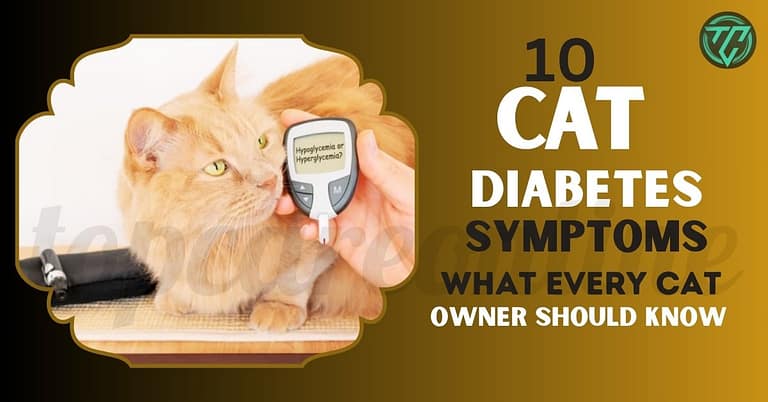Cat Diabetes Symptoms | Intermediate Cat Diabetes | Advanced Cat Diabetes
Are you afraid your cat is facing Cat Diabetes Symptoms? Diabetes in cats, much like in humans, is a serious condition that affects the way a cat’s body regulates glucose, or blood sugar. Specifically, it involves issues with the production or effectiveness of insulin, a hormone essential for converting glucose into energy.
When insulin is insufficient or ineffective, glucose accumulates in the bloodstream, leading to hyperglycemia. Understanding Cat Diabetes Symptoms is crucial for pet owners, as it can significantly impact a cat’s health and quality of life.
Cat diabetes, or feline diabetes mellitus, is relatively common, with estimates suggesting it affects between one in 200 to one in 400 cats. However, these numbers could be higher due to underdiagnosis.
Read More
Early detection and management are vital, as untreated diabetes can lead to severe complications. These include ketoacidosis, neuropathy, and even death. Moreover, diabetes can compromise a cat’s immune system, making them more susceptible to infections and other ailments.
Insulin regulation plays a central role in diabetes management. In healthy cats, insulin helps cells absorb glucose from the blood, providing energy for bodily functions. In diabetic cats, either the pancreas does not produce enough insulin, or the body’s cells do not respond properly to it.
This condition closely mirrors type 2 diabetes in humans, where insulin resistance is a key issue. Over time, persistent high glucose levels can damage organs, nerves, and blood vessels, further complicating the cat’s health.
By understanding the basics of cat diabetes and the importance of early symptom detection, cat owners can take proactive steps to ensure their feline companions lead healthier, happier lives.
Early Cat Diabetes Symptoms
Recognizing Cat Diabetes Symptoms early is crucial for timely intervention and management. One of the first Cat Diabetes Symptoms you might observe is increased thirst, known as polydipsia. Cats with diabetes often drink more water than usual because their bodies are attempting to flush out excess glucose through urine.
This condition is closely related to another symptom, frequent urination or polyuria. If your cat is visiting the litter box more often, producing larger volumes of urine, or having accidents outside the box, it could be a sign of diabetes.
Another early symptom to watch for is unexplained weight loss. Even if your cat is eating normally or more than usual, weight loss can occur because diabetes prevents the body from effectively utilizing glucose for energy. Instead, the body starts breaking down fat and muscle tissue to compensate, leading to noticeable weight loss. Monitoring your cat’s weight regularly can help you catch this symptom early.
Increased appetite, or polyphagia, is also a common early warning sign. Despite consuming more food, a diabetic cat’s body struggles to convert food into energy, leading to persistent hunger. If you notice your cat constantly begging for food or displaying an uncharacteristic increase in appetite, it may be time to consult a veterinarian.
By understanding these early warning signs—polydipsia, polyuria, unexplained weight loss, and polyphagia—cat owners can take proactive steps in recognizing potential diabetes. Early detection is key to managing the condition effectively and improving the quality of life for your feline friend.
Regular veterinary check-ups and being vigilant about changes in your cat’s behavior and physical condition are essential practices for any responsible cat owner.
Intermediate Cat Diabetes Symptoms
As feline diabetes progresses, cat owners may observe intermediate symptoms that signal the worsening of the condition. Some Intermediate Cat Diabetes Symptoms are mentioned below:
- Lethargy: One of the most noticeable signs is lethargy or decreased activity levels. Diabetic cats often experience a significant drop in energy, leading them to sleep more and show little interest in play or physical activities. This occurs because their bodies are unable to effectively convert glucose into energy, leading to fatigue and decreased stamina. Cat owners should monitor their pets for any sudden or prolonged changes in activity levels, as this can be an Cat Diabetes Symptoms.
- Poor coat condition: Another intermediate symptom is a poor coat condition. Diabetic cats may exhibit dull or thinning fur, which can be attributed to the body’s inability to properly utilize nutrients. Insufficient insulin levels can lead to an imbalance in the skin and coat health, resulting in a lacklustre appearance. Regular grooming and close observation of the cat’s fur condition can help in identifying this symptom early. If the coat appears unusually dull or begins to thin out, it may be time to consult a veterinarian for further evaluation.
- Diabetic neuropathy: Weakness in the hind legs, known as diabetic neuropathy, is a more severe symptom that can develop as diabetes progresses. This condition arises from prolonged high blood sugar levels that damage the nerves, particularly those in the hind legs. Cats with diabetic neuropathy may have difficulty jumping, climbing, or even walking, often displaying an unusual gait or stance. This symptom can significantly affect a cat’s overall mobility and quality of life. To monitor for diabetic neuropathy, observe your cat’s movement patterns and look for any signs of weakness or instability in the hind legs.
Recognizing these intermediate Cat Diabetes Symptoms early can help in managing feline diabetes more effectively. Regular veterinary check-ups, combined with vigilant home monitoring, can make a significant difference in the health and well-being of diabetic cats. Understanding these signs allows for timely intervention, potentially preventing further complications.
Advanced Cat Diabetes Symptoms
When a cat’s diabetes progresses to an advanced stage, the Cat Diabetes Symptoms become more severe and can pose significant health risks. Among these critical symptoms are vomiting, depression or unresponsiveness, and ketoacidosis. Recognizing these Cat Diabetes Symptoms is vital as they necessitate immediate veterinary intervention to prevent life-threatening complications.
Vomiting is an alarming symptom that often indicates a serious imbalance in the cat’s metabolism. In diabetic cats, frequent vomiting can be a result of high blood sugar levels leading to gastrointestinal distress.
This is not just an isolated event but a sign that the body is struggling to manage glucose levels effectively. Persistent vomiting requires swift veterinary evaluation to determine the underlying cause and to stabilize the cat’s condition.
Depression or unresponsiveness in a diabetic cat is another grave symptom. Cats with advanced diabetes might exhibit lethargy or a noticeable decrease in their usual responsiveness. This behavior change can be attributed to the body’s inability to utilize glucose properly, leading to an energy deficit. Such symptoms reflect the cat’s declining health and necessitate urgent medical attention to adjust their diabetes management plan and to prevent further deterioration.
Ketoacidosis, a severe and potentially fatal complication, occurs when the body starts breaking down fat at an excessive rate due to insufficient insulin. This process produces ketones, which accumulate in the blood, leading to a state known as diabetic ketoacidosis (DKA).
Symptoms of ketoacidosis include intense thirst, frequent urination, lethargy, and a distinctive fruity smell on the cat’s breath. Without immediate treatment, ketoacidosis can rapidly become life-threatening. Veterinary care for DKA involves fluid therapy, insulin administration, and close monitoring to restore metabolic balance.
Observing any of these advanced Cat Diabetes Symptoms is a clear indicator that the disease is not well-controlled and that the cat is in urgent need of professional veterinary care. Prompt and appropriate treatment can make a significant difference in the outcome and quality of life for cats suffering from advanced diabetes.



